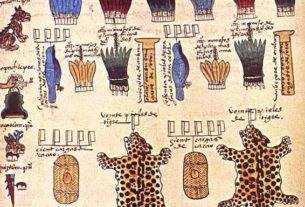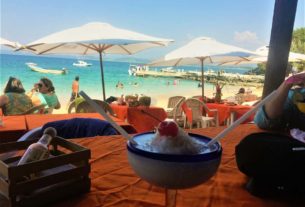In my original booklet on traveling the Central High Plains, we traveled to Poza Rica by way of Xicotepec and La Ceiba, one of the principal routes between Mexico City and Poza Rica. Since I have used some of the material in other articles, we will take a different return route and visit some of the more out-of-the-way places, places that are not normally visited by American tourists.
Our first stop is Cuetzalan (Quetzalan), in the northeast mountainous area of the state of Puebla. Mileage-wise it is not that far from El Tajin, as the crow flies. Driving secondary roads seems like a lifetime, but a pleasant lifetime. One sees a lovely church across the valley, and a half-hour later it is passed by.
This is an area of deep valleys, tropical vegetation and crystal clear rivers. At one point, where the road to Cuetzalan branches off, I took a video of waterfalls across the valley. It poured out of the mountains in a single stream and then broke-up into many parts as it cascaded down various levels. Unfortunately we did not have time to take a closer look, but I assume it was several hundred feet high.
It was around 9:30 or 10 o’clock in the evening. It was warm but pleasant sitting in the plaza. Birds chirped in the trees above, children played quietly and unsupervised, adults visited one another, as though they were not aware of the hour. The massive, unlit, cut-stone church stood like a shadow in one corner of the plaza, with the same solidity and strength it had shown a hundred or more years ago. Next to it was the beautiful ‘ Palacio‘ or government building. It was indeed a small Palace. It’s white façade and columns glistened from the park lights.
I was conscious of a sense of peace, to a degree, which perhaps I had not felt before. I have been asked to explain this. It might have been easier to do it while I was there. I felt as though I, and the people around me, were in a different time and place. There were no signs of animosity, aggressiveness, hostility, prejudice, or arrogance. We were just people enjoying a quiet evening in a lovely park, in a beautiful little town, somewhat isolated from the rest of the world.
Thoughts ran through my mind. How could such a small town accommodate such a ‘ Palacio‘ and such a grand church. It was an old town. It was something like a county seat. And it was a coffee center. I had earlier bought a couple of pounds of 100% pure ground coffee of the area, in neat plastic bags with an outline drawing of their church.
I thought of my little Citlali who was at home.
Yesterday I had met a shop owner, Señor Fernanado Gramutges. He was a lively 81 years old man, born in Spain who had traveled the five continents. Fifty years ago he had come to Cuetzalan, married and lived happily ever after. To him there was no place like Mexico.
And there was no place like Cuetzalan.
He had served as ‘ presidente‘ (mayor) of the town for two terms. Hanging on the wall was a picture of he and the President of Mexico and the Governor of Puebla, posing on the balcony of the beautiful Palacio. He spoke both Nahuatl and Totonaca. In a brief period we had become friends.
Cuetzalan is a town of maybe 10,000 inhabitants. Most of the buildings are of stone and the streets are paved with stone. Some of the streets are narrow and crooked reminding me of Taxco, Guerrero. Though it is built on the side of a mountain, the grade is not as steep as Taxco, nor is it as crowded and busy.
I had heard tales of the area. Tales of unexplored caves, pre-Columbian ruins, abandoned mines and an ‘ artesanias‘ market. Nothing was exactly as I envisioned it to be. It never is. But I was not disappointed in the least.
With the help of Miguel we found caves near the town of Nauzantla. Nauzantla is about 30 minutes from Cuetzalan, five minutes as the crow flies. It is a town of remarkable cleanliness and absence of litter in the streets and plaza.. They say Cortez passed through the town on his way to Tenochtitlan. I have still to discover which trip that was. Several branches of the caves had been silted to a dead-end. I took off my shoes and waded knee deep in another and as far as I could see there was still water so I put it off till another day, till I had better lighting and short pants. At least there were no scorpions clinging to the walls as I had found in other explorations. Miguel did point out one small spider, which he claimed was lethal. I think I need to talk to a psychiatrist to find out why I do some of the things I do.
Later in the day we visited the relatively small archaeological site of Yohualichin, which is on the other side of Cuetzalan. I was surprised to see that all of the structures were built with niches, in the same manner as those of El Tajin. It is commonly believed in the area that the site was built by the Totonaca who later moved to the coastal area and built El Tajin. The indigenous people who now occupy the area are the Nahua. The entrance to the site is well guarded by Nahuatl speaking ladies in their beautiful dresses selling various items from the area. I bought a small bag of black pepper . I guess they are seeds which are to be ground-up. There were also numerous little kids asking for coins. The worst was a tenacious little old lady. I could visualize her at night, sitting alone by candlelight, counting her hoarded piles of coins.
As we drove down the stone paved road to the site, little boys ran alongside the car. They introduced us to the ‘ puma rosa‘, which is a fruit that grows on tall trees alongside the road. The fruit somewhat resembles a large yellow plum, though it isn’t juicy, with a round seed inside that can rattle around. It tasted good. My brother-in-law, Vidal, who was born in the higher part of Puebla, had never heard of it either.
Sunday was the main market day in Cuetzalan. There were really not that many city tourists as far as I could see. Not only was the Plaza area filled with vendors, but their stalls occupied one street off the Plaza for maybe four blocks. The Nahua do not normally live in town. They live in their own villages where their customs and traditions can be preserved. On any day of the week you find them in the streets of Cuetzalan, taking care of whatever business they have to take care of. On market days and special days of celebration, they are more numerous. They add color and interest to the town. The women and little girls wear white dresses with colorful embroidery at the neck, hems, etc. (I bought dresses for little Citlali and Diana). The men generally wear white ‘ calzones‘, loose fitting white shirts, and straw hats. They seem proud of their dress.
The markets are interesting, if for no other reason, for the quantity, variety and color of the fresh fruits and vegetables. I tried to make a list: pineapples, coconuts, peanuts, vanilla, coffee, black pepper, mangos, potatoes, cabbage, carrots, onions, garlic, habas, a large variety of beans, lettuce, beets, grapes, huge red radish type things, corn (ears and dry kernels), cilantro, mamey, puma rosa, guayaba, bananas, papaya, avacados, cantalopes, watermelons, tomatoes, jicama, all types of chilis and on and on. Then there was also fresh fish, carcasses of hogs, cut flowers, shoes and sandals, etc. The vendors could have supplied a small army.
Before leaving town I bought eight wooden masks which are used in ceremonial dances in the area. In visiting another shop I was attracted to some paintings which depicted indigenous people of the area. I asked about the artist, Gregorio Mendez Nava, and the lady graciously gave me his address and directions on how to get there. We stopped by on our way out of town and I bought a painting. I learned that his first language was Nahuatl and he had learned Spanish in school. He had been born in a village not far from Quetzalan. I also learned that the National Institute of Anthropological Research had sponsered an exhibition for his work in Mexico City.
Before we took our leave, I commented, “There seems to be a certain inner peace and calmness in all of the people in your paintings.”
His reply was, “It is typical of the people in the Cuetzalan area.”
It was the reply I had hoped for.


